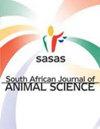远红外线照射对不同生产阶段蛋鸡生产性能、血液生化及粪便微生物群的影响
IF 0.6
4区 农林科学
Q3 AGRICULTURE, DAIRY & ANIMAL SCIENCE
引用次数: 0
摘要
本试验旨在研究远红外光照对不同生产阶段蛋鸡生产性能、血液生化和粪便微生物群的影响。试验选用360只海兰褐蛋鸡,按2 × 2因子随机分配,共6个重复。母鸡分为两个生产阶段(30-39周龄和45-54周龄)。每组暴露在两种光下(发光二极管;LED和LED+FIR)在不同的房间。LED处理的发光波长为650±10 nm(0.65±0.01 μm),而LED+FIR处理的发光波长为15±10 μm。结果表明,产蛋期和光照类型对血清甘油三酯浓度有交互作用。LED+FIR处理和LED处理的蛋鸡产蛋量、采食量、蛋重、饲料系数(FCR)、鸡蛋蛋白高度、哈夫单位和蛋壳厚度基本相同。与LED照明相比,LED+FIR显著降低了血清胆固醇(CHOL)、高密度脂蛋白胆固醇(HDLC)和甘油三酯(TG)的浓度。与暴露在LED光下的鸟类相比,LED+FIR大大减少了粪便中微生物总数、大肠杆菌和沙门氏菌的数量。这些结果表明,LED+FIR灯可以改善母鸡健康和鸡舍环境。本文章由计算机程序翻译,如有差异,请以英文原文为准。
Effects of far infrared ray illumination on the performance, blood biochemistry, and faecal microflora of laying hens at different production stages
This study investigated the effect of far-infrared ray (FIR) illumination on performance, blood biochemistry, and faecal microflora of laying hens at different production stages. A total of 360 Hy-line brown laying hens were randomly allocated in a 2 × 2 factorial arrangement with six replicates. Hens were distributed in two production stages (30–39 and 45–54 weeks-old). Each group was exposed to two light types (light emitting diode; LED and LED+FIR) in separate rooms. The LED treatment illuminated a wavelength of 650 ± 10 nm (0.65 ± 0.01 μm), while LED+FIR treatment emitted 15 ± 10 μm with an LED wavelength. The results showed an interaction between egg production stages and light types on the serum triglyceride concentration. The hens exposed to the LED+FIR and LED treatments showed similar egg production, feed intake, egg weight, feed conversion ratio (FCR), as well as albumen height, haugh unit, and shell thickness of eggs. LED+FIR substantially decreased the concentration of serum cholesterol (CHOL), HDL cholesterol (HDLC), and triglyceride (TG) compared to LED lighting. LED+FIR substantially reduced the number of total microbes, Escherichia coli, and Salmonella in faeces compared to birds exposed to LED light. These findings suggest that LED+FIR lights may improve hen health and the hen house environment.
求助全文
通过发布文献求助,成功后即可免费获取论文全文。
去求助
来源期刊

South African Journal of Animal Science
农林科学-奶制品与动物科学
CiteScore
1.50
自引率
0.00%
发文量
39
审稿时长
>36 weeks
期刊介绍:
The South African Journal of Animal Science is an open access, peer-reviewed journal for
publication of original scientific articles and reviews in the field of animal science. The journal
publishes reports of research dealing with production of farmed animal species (cattle, sheep,
goats, pigs, horses, poultry and ostriches), as well as pertinent aspects of research on aquatic
and wildlife species. Disciplines covered nutrition, genetics, physiology, and production
systems. Systematic research on animal products, behaviour, and welfare are also invited.
Rigorous testing of well-specified hypotheses is expected.
 求助内容:
求助内容: 应助结果提醒方式:
应助结果提醒方式:


